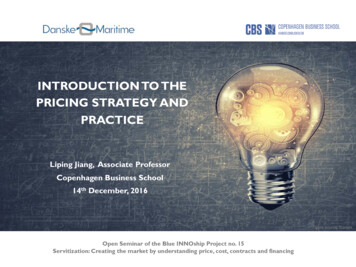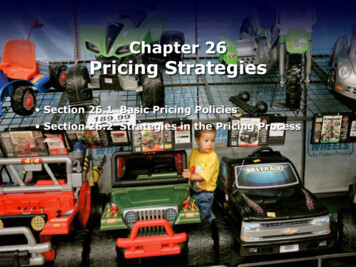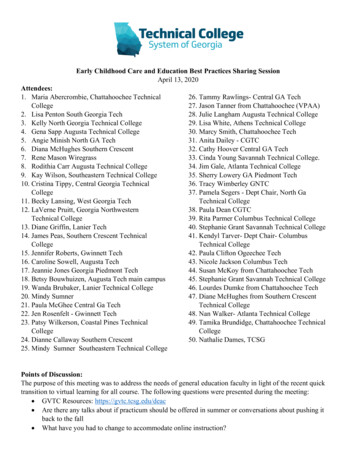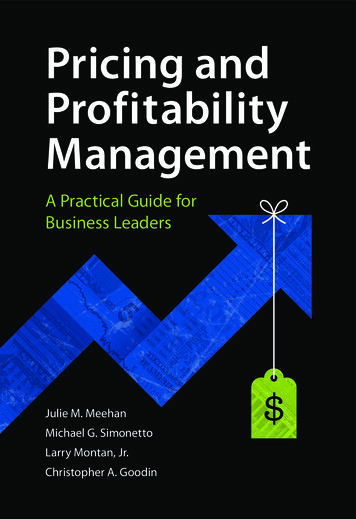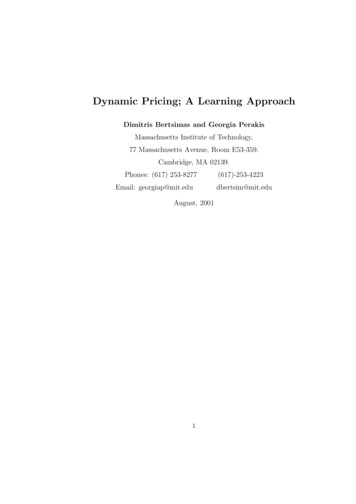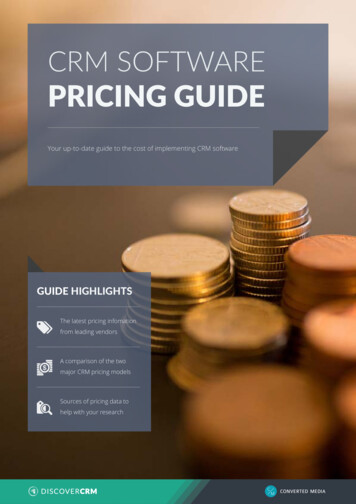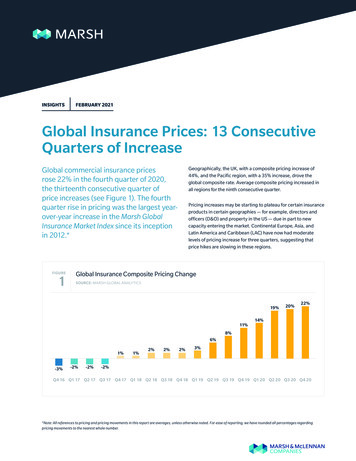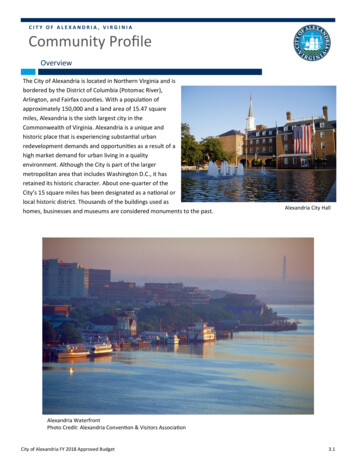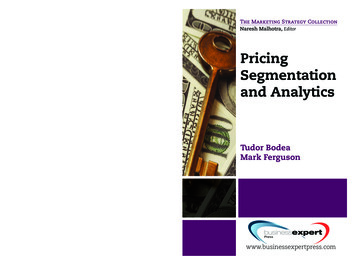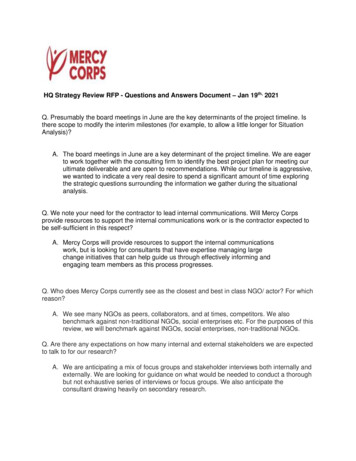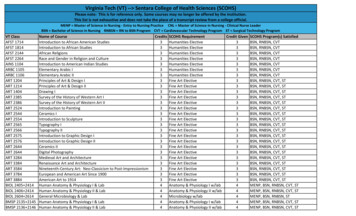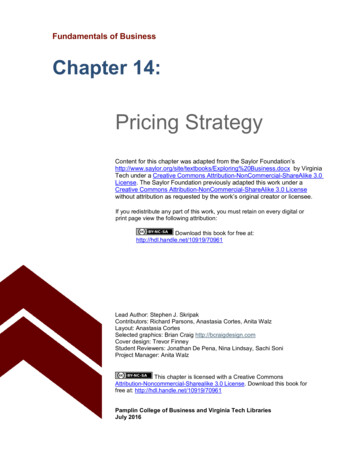
Transcription
Fundamentals of BusinessChapter 14:Pricing StrategyContent for this chapter was adapted from the Saylor /Exploring%20Business.docx by VirginiaTech under a Creative Commons Attribution-NonCommercial-ShareAlike 3.0License. The Saylor Foundation previously adapted this work under aCreative Commons Attribution-NonCommercial-ShareAlike 3.0 Licensewithout attribution as requested by the work’s original creator or licensee.If you redistribute any part of this work, you must retain on every digital orprint page view the following attribution:Download this book for free at:http://hdl.handle.net/10919/70961Lead Author: Stephen J. SkripakContributors: Richard Parsons, Anastasia Cortes, Anita WalzLayout: Anastasia CortesSelected graphics: Brian Craig http://bcraigdesign.comCover design: Trevor FinneyStudent Reviewers: Jonathan De Pena, Nina Lindsay, Sachi SoniProject Manager: Anita WalzThis chapter is licensed with a Creative CommonsAttribution-Noncommercial-Sharealike 3.0 License. Download this book forfree at: http://hdl.handle.net/10919/70961Pamplin College of Business and Virginia Tech LibrariesJuly 2016
Chapter 14Pricing StrategyLearning Objectives1) Identify pricing strategies that are appropriate for new andexisting products2) Understand the stages of the product life cycle.314Download this book for free at:http://hdl.handle.net/10919/70961Chapter 14
Pricing a ProductAs introduced in a previous chapter, one of the four Ps in the marketing mix is price.Pricing is such an important aspect of marketing that it merits its own chapter. Pricing aproduct involves a certain amount of trial and error because there are so many factors toconsider. If a product or service is priced too high, many people simply won’t buy it. Or yourcompany might even find itself facing competition from some other supplier that thinks it canbeat your price. On the other hand, if you price too low, you might not make enough profit tostay in business. Let’s look at several pricing options that were available to those marketers atWow Wee who were responsible for pricing Robosapien, an example we introduced earlier.We’ll begin by discussing two strategies that are particularly applicable to products that arebeing newly introduced.New Product Pricing StrategiesWhen Robosapien was introduced to theFigure 14.1 Sony’s robot dog, Aibo.market, it had little direct competition in its productcategory. True, there were some “toy” robotsavailable, but they were not nearly as sophisticated.Sony offered a pet dog robot called Aibo, but its pricetag of 1,800 was really high. Even higher up theprice-point scale was the 3,600 iRobi robot made bythe Korean company Yujin Robotics to entertain kidsand even teach them foreign languages. Parentscould also monitor kids’ interactions with the robotthrough its video-camera eyes; in fact, they could evenuse the robot to relay video messages telling kids toshut it off and go to sleep.1Skimming and Penetration PricingBecause Wow Wee was introducing an innovative product in an emerging market withfew direct competitors, it considered one of two pricing strategies:Chapter 14Download this book for free at:http://hdl.handle.net/10919/70961315
1) With a skimming strategy, Wow Wee would start off with the highest price thatkeenly interested customers would pay. This approach would generate early profits,but when competition enters—and it will, because at high prices, healthy profits canbe made in the market—Wow Wee would have to lower its price. Even withoutcompetition, they would likely lower prices gradually to bring in another group ofconsumers not willing to pay the initial high price.2) Using penetration pricing, Wow Wee would initially charge a low price, both todiscourage competition and to grab a sizable share of the market. This strategymight give the company some competitive breathing room (potential competitorswon’t be attracted to low prices and modest profits). Over time, as its dominatingmarket share discourages competition, Wow Wee could push up its prices.Other Pricing StrategiesIn their search for the best price level, Wow Wee’s marketing managers could considera variety of other approaches, such as cost-based pricing, demand-based pricing, prestigepricing, and odd-even pricing. Any of these methods could be used not only to set an initialprice but also to establish long-term pricing levels.Before we examine these strategies, let’s pause for a moment to think about the pricingdecisions that you have to make if you’re selling goods for resale by retailers. Most of us thinkof price as the amount that we—consumers—pay for a product. But when a manufacturer(such as Wow Wee) sells goods to retailers, the price it gets is not what we the consumers willpay for the product. In fact, it’s a lot less.Here’s an example. Say you buy a shirt at the mall for 40 and that the shirt was sold tothe retailer by the manufacturer for 20. In this case, the retailer would have applied amark-up of 100 percent to this shirt, or in other words 20 mark-up is added to the 20 cost toarrive at its price (hence a 100% markup) resulting in a 40 sales price to the consumer. Markup allows the retailer to cover its costs and make a profit.Cost-Based PricingUsing cost-based pricing, Wow Wee’s accountants would figure out how much it coststo make Robosapien and then set a price by adding a profit to the cost. If, for example, it cost 40 to make the robot, Wow Wee could add on 10 for profit and charge retailers 50. Cost316Download this book for free at:http://hdl.handle.net/10919/70961Chapter 14
based pricing has a fundamental flaw – it ignores the value that consumers would place on theproduct. As a result, it is typically only employed in cases where something new or customizedis being developed where the cost and value cannot easily be determined before the product isdeveloped. A defense contractor might use cost-based pricing for a new missile system, forexample. The military might agree to pay costs plus some agreed amount of profit to create theneeded incentives for the contractor to develop the system. Building contractors might also usecost-based pricing to protect themselves from unforeseen changes in a project: the clientwanting a home addition would get an estimate of the cost and have an agreement foradministrative fees or profit, but if the client changes what they want, or the contractor hasunexpected complications in the project, the client will pay for the additional costs.Demand-Based PricingLet’s say that Wow Wee learns through market research how much people are willing topay for Robosapien. Following a demand-based pricing approach, it would use thisinformation to set the price that it charges retailers. If consumers are willing to pay 120 retail,Wow Wee would charge retailers a price that would allow retailers to sell the product for 120.What would that price be? If the 100% mark-up example applied in this case, here’s how wewould arrive at it: 120 consumer selling price minus a 60 markup by retailers means thatWow Wee could charge retailers 60. Retailer markup varies by product category and byretailer, so this example is just to illustrate the concept.Dynamic PricingIn the hospitality industry, the supply of available rooms or seats is fixed; it cannot bechanged easily. Moreover, once the night is over or the flight has departed, you can no longersell that room or seat. This fact combined with the variation in demand for rooms or flights oncertain days or times (think holidays or special events), has led to dynamic pricing. Revenuemanagement, and the growth of online travel agencies (OTA’s) like Hotwire, Expedia, andPriceline are methods of maximizing revenue for a given night or flight. Hotels and airlinesuse sophisticated revenue management tools to forecast demand and adjust the availabilityof various price points. Online travel agents like Hotwire publicize last-minute availability withspecial rates so that unsold rooms or flights can attract customers and still earn revenue. Thisapproach allows hotels and airlines to maximize revenue opportunities for high demand timessuch as university graduations and holidays, and also for special events like the Super Bowl orChapter 14Download this book for free at:http://hdl.handle.net/10919/70961317
the Olympics. Losses are minimized during low-demand times because unused capacity isoffered at a discount, attracting customers who might not have considered travelling at off peaktimes.Prestige PricingSome people associate a high price with high quality—and, in fact, there generally is acorrelation. Thus, some companies adopt a prestige-pricing approach—setting pricesartificially high to foster the impression that they’re offering a high-quality product.Competitors are reluctant to lower their prices because it would suggest that they’relower-quality products. Let’s say that Wow Wee finds some amazing production method thatallows it to produce Robosapien at a fraction of its current cost. It could pass the savings on bycutting the price, but it might be reluctant to do so: what if consumers equate low cost withpoor quality?Figure 14.2: Odd-even pricing—it’s lessthan 60.00!Odd-Even PricingDo you think 9.99 sounds cheaper than 10? If you do, you’re part of the reason thatcompanies sometimes use odd-even pricing—pricing products a few cents (or dollars) under aneven number. Retailers, for example, might priceRobosapien at 99 (or even 99.99) if they thoughtconsumers would perceive it as less than 100.Loss LeadersHave you ever seen items in stores that were priced so low that you wondered how thestore could make any money? There’s a good chance they weren’t – the store may have beenusing a loss leader strategy – pricing an item at a loss to draw customers into the store. Oncethere, store managers hope that the customer will either buy accessories to go along with thenew purchase or actually select a different item not priced at a loss. You might have visited thestore to buy a specially-priced laptop and ended up leaving with a more expensive one thathad a faster processor. Or perhaps you bought the HDTV that was advertised, but then alsobought a new surge protector and a streaming player. In either case, you did exactly what the318Download this book for free at:http://hdl.handle.net/10919/70961Chapter 14
store hoped when they priced the advertised item at a loss.BundlingPerhaps you are one of the many customers of a cable television provider that alsobuys their high-speed internet and/or their phone service. Or when you stop by your favoritefast-food outlet for lunch, maybe you sometimes buy the combo of burger, fries, and a drink. Ifyou do, you’ve experienced the common practice of a bundling strategy – pricing items as agroup, or bundle, at a discount to the cost of buying the items separately. Bundling hassignificant advantages to both buyers and sellers. Obviously, buyers receive the discount.Sellers, on the other hand, can sell more goods and services with this approach. Perhaps youwould have settled for a water instead of a soft drink, but the combo price made the soft drinkjust a few cents more. Without bundling, that soft drink might not have been sold.If the sale involves some kind of recurring service – like the previously-mentionedexample of cable – bundling can also result in higher levels of customer retention. If youdecided one day that you wanted to replace your cable with satellite TV, for example, youmight well find that the discount from moving to satellite was far less than you expected,because unbundled from cable TV, the price for your internet service could take a substantialjump. If so, like many others who have likely considered making this move, you might find it inyour best interests to stick with the original bundled package, no matter how trapped orfrustrated you might feel as a result.Chapter 14Download this book for free at:http://hdl.handle.net/10919/70961319
The Product Life CycleFigure 14.3: A Toyota RAV-4, a top-selling small sized SUV.Sport utility vehicles (SUVs) are among the most popular categories of passenger caron U.S. roads. Offering an elevated view of the road, the safety that comes with size, spaciousinterior and cargo areas, and often superior handling performance in bad weather – especially4-wheel-drive SUVs – it is no wonder that American consumers have bought tens of millions ofthese vehicles. For a long time, SUV sales followed close to the classical pattern of what isknown as the product life cycle:Figure 14.4: The Product Life Cycle320Download this book for free at:http://hdl.handle.net/10919/70961Chapter 14
Yet in 2009, when the economy faltered due to the financial crisis and oil prices surgedfrom about 40 a barrel to nearly 80,2 many pundits declared the SUV to be in permanentFigure 14.5: SUV sales by category, 1990-2012decline. In fact, the data appeared to support this contention:As you can see from the figure, SUV sales did in fact decline, rather dramatically. ButSUV sales are too critical to the profitability of the major automakers for them to just watchtheir cash flows disappear.3 Instead, the automakers redesigned their products, including anincreased emphasis on smaller SUVs. In fact, the Honda CR-V and the Toyota RAV4, two ofthe smaller SUV’s on the market, now battle each other for the crown of top-selling SUV in theU.S.4 Many consumers adapted their budgets to compensate for higher oil prices. Sales,particularly of mid-sized SUVs, roared back in 2010, with sales of large SUV’s showing asimilar, but smaller, upward trend too.While their new designs certainly helped to reinvigorate sales, more recentlyautomakers have gotten a somewhat unexpected additional boost from declining oil prices. Forall their benefits, SUVs are not the most fuel efficient cars on the market. But as consumersbegan to pay less at the pump, the cost of operating SUVs declined, and SUV sales havecontinued to be strong. Automakers continue to invest in new models – for example, Germanautomaker Volkswagen introduced a new 5-seat mid-sized SUV at the Detroit auto show inChapter 14Download this book for free at:http://hdl.handle.net/10919/70961321
January, 2015. The company is assembling a group of about 200 experts, includingrepresentatives of its dealer network, to help it better cater its offerings to the Americanmarket.5Many products tend to follow the classical product life cycle pattern of Figure 14.4. Let’stake a closer look at the product life cycle and see what we can learn from it. The graph is asimplified depiction of the product life cycle concept. Many products never make it past theintroduction stage. Some products avoid or reverse decline by reinventing themselves. In part,reinvention is what the SUV market has experienced, in addition to the boost it has receivedfrom lower gas prices.The Life Cycle and the Changing Marketing MixAs a product or brand moves through its life cycle, the company that markets it will shiftits marketing-mix strategies. Figure 14.6 summarizes the market and industry features of eachstage. Let’s see how the mix might be changed to address the differences from one stage toFigure 14.6: The Product Life Cycle: characteristics of each stage.the s on choiceof introductorystrategyConverges ascompetitorsenter marketInitially high buttend to decline asgrowth disappearsInitially declinesbut may rise ascompetitors exitFewRapidly RisingBegins to declinethroughconsolidationFew or oneNegativeRisingHighestDecliningCustomersFew – InnovatorsOnlyRising – EarlyAdoptersHigh/Stable, beginsto drop late in cycleDecliningObjectivesAwareness andAdoptionGain MarketShareDefend Share andMaximize ProfitsMilk RemainingValue, MinimizeInvestmentPrice LevelsNumber ofCompetitorsIndustryProfits322Download this book for free at:http://hdl.handle.net/10919/70961Chapter 14
Introduction StageAt the start of the introduction stage, people – otherthan those who work in the industry – are likely to beFigure 14.7: Google Glasscompletely unaware that a product even exists. Buildingawareness is a key to adoption of the product. Companiesinvest in advertising to make consumers aware of theirofferings and the benefits of becoming a customer. For manyproducts, the early adopters are people who value newnessand innovation. If a company faces only limited competition, itmight use a skimming approach to pricing because peoplewho want to be among the first to have the product willgenerally be willing to pay a higher price (recall that“skimming” means that the company will set initial prices high,and only those consumers who feel especially excited about the product will buy it). Thecompany will then lower prices to appeal to the next layer of consumers – those who wantedthe product but were unwilling to pay the high introductory price. The company will continue togradually lower prices, in effect taking off layer after layer of potential customers until theproduct is priced low enough to be afforded by the mass market.If the company has or expects a lot of competition, though, it may decide to usepenetration pricing and capture a lot of market share, which may discourage some potentialcompetitors from entering the market at all. The higher the price levels in a market, the morelikely it is that new competitors will want to enter.During the introductory stage, the industry as whole will sell only a relatively smallquantity of the product, so competitors will distribute the product through just a few channels.Most retailers charge what is called a “slotting fee” – a payment the manufacturer makes topersuade the retailer to stock the item. If the product fails, they do not offer refunds on thesecharges, so producers will want to be confident that a product will draw enough customersbefore they pay these fees and so may limit its initial distribution. Because sales at this stageare low while advertising and other costs are high, all competitors tend to lose money duringthis stage.Chapter 14Download this book for free at:http://hdl.handle.net/10919/70961323
Growth StageAs the competitors in an industry focus on building sales, successful products will entera stage of rapid customer adoption, which is not surprisingly called the growth stage in theproduct life cycle. Depending on how innovativeand attractive a product is, the industry mightFigure 14.8: A Samsung smart watchreach the growth stage relatively quickly – or itcould take many months or even longer for thatpoint to arrive, if it happens at all. In order forindustry sales to increase rapidly, advertisingcosts will generally be very high during the growthstage. If competition appears, companies mayrespond by lowering prices to retain their marketshares. Competitors will also be looking forchannels in which to distribute their products. Where possible, they will try to establishexclusive arrangements with distributors, at least for a period of time, so that their product maybe the only one available in a product category at a particular retail outlet. During the growthstage, it is also important for companies to invest in making improvements to their products soas to maintain any advantage they may have established over their competitors. Since salesare rising rapidly during the growth stage, many products begin to turn a profit here, eventhough they are still investing heavily in advertising, establishing distribution, and refining theproduct itself.Maturity StageFigure 14.9: SmartphonesIf a product survives the growth stage,it will probably remain in the maturity stagefor a long time. Sales still grow in the initialpart of this stage, though at a decreasingrate. Later in the maturity stage, sales willplateau and eventually begin to move in aslightly downward direction. By this stage, ifnot sooner, competitors will have settled on astrategy intended to deliver them a324Download this book for free at:http://hdl.handle.net/10919/70961Chapter 14
sustainable competitive advantage – either by being the low cost producer of a product, or bysuccessfully differentiating their product from the competition. Since at least one competitor willgenerally move towards a low-cost strategy, after initially peaking, price levels begin to declineduring the maturity stage. Price wars may even occur, but profits still tend to be strongbecause sales volume remains high.As the product becomes outdated, the company may make changes in keeping withchanging consumer preferences, but usually not as rapidly as in the earlier stages of the life ofa product. Branding becomes a key aspect of success in the maturity stage, particularly forthose companies seeking to differentiate their products as their source of competitiveadvantage. Also during the maturity stage, industry consolidation is high; in other words, largercompetitors will buy up smaller competitors in order to find synergies and build share and scaleeconomies. Some models of the product life cycle reflect a stage called “shakeout”, whichoccurs towards the end of the growth and the beginning of the maturity stages. The termshakeout reflects this trend towards industry consolidation. Some competitors survive andothers get “shaken out,” either by going out of business or by being acquired by a strongercompetitor.Decline StageFigure 14.10: a landline phoneAt some point, virtually every product will reach thedecline stage, the point at which sales drop significantly.New innovations, changes in consumer tastes, regulations,and other forces from the macro-level businessenvironment can change the outlook for a product almostovernight. Products with a very short life cycle are knownas “fads”. They may move through the entire product lifecycle in a matter of months. Many products, particularlythose which have experienced a long period in maturity,may stay in the decline phase for years. Ironically, price levels during the decline stage mayactually increase, which occurs because the number of competitors is few – in fact, there maybe only one remaining, giving that company great pricing power over the few consumers whostill want or need the product. New product development is usually very limited, unless acompany believes that innovation can restart growth in the category, as we saw with new SUVChapter 14Download this book for free at:http://hdl.handle.net/10919/70961325
models. Also, advertising is typically limited or non-existent – those who need the product arelikely to know about it already. So while it may seem counter-intuitive, many companies makea lot of money while they are riding the downward shape of the product life cycle curve duringthe decline stage.326Download this book for free at:http://hdl.handle.net/10919/70961Chapter 14
Key Take-Aways1) There are several pricing strategies appropriate for differentproduct and market situations:a. A new product can be introduced with a skimmingstrategy—starting off with a high price that keenlyinterested customers are willing to pay. The alternative is apenetration strategy, charging a low price, both to keepout competition and to grab as much market share aspossibleb. With cost-based pricing, a company determines the costof making a product and then sets a price by adding a profitto the cost.c. With demand-based pricing, marketers set the price thatthey think consumers will pay.d. Companies use prestige pricing to capitalize on thecommon association of high price and quality, setting anartificially high price to substantiate the impression of highquality.e. Finally, with odd-even pricing, companies set prices atsuch figures as 9.99 (an odd amount), counting on thecommon impression that it sounds cheaper than 10 (aneven amount).Chapter 14Download this book for free at:http://hdl.handle.net/10919/70961327
Key Take-Aways2) The stages of development and decline that products gothrough over their lives is called the product life cycle.3) The stages a product goes through are introduction,growth, maturity, and decline.4) As a product moves through its life cycle, the company thatmarkets it will shift its marketing-mix strategies.328Download this book for free at:http://hdl.handle.net/10919/70961Chapter 14
Chapter 14 Text References and ImageCreditsImage Credits: Chapter 14Figure 14.1: Kate Nevens (2005). “Aibo.” CC BY-SA 2.0. Retrieved 1Figure 14.2: BrokenSphere / Wikimedia Commons (2010). “FF XIII Xbox 360 versionprice tag with gift card offer at Target.” CC BY-SA 3.0 Retrieved from:https://commons.wikimedia.org/wiki/File:FF XIII Xbox 360 version price tag with gift card offer atTarget, Tanforan.JPGFigure 14.3: Mr. Choppers (2013). “A 2013 Toyota RAV4 XLE AWD.” CC BY-SA 3.0. Retrieved from:https://en.wikipedia.org/wiki/Toyota RAV4#/media/File:2013 Toyota RAV4 XLE AWD front left.jpg.Figure 14.5: SUV sales and gas prices: Data sources: Office of Energy Efficiency & Renewable Energy(2016). “Fact #915: March 7, 2016 Average Historical Annual Gasoline Pump Price, 1929-2015.”Energy.gov. Retrieved from: 929-2015 and United States Department of Transportation Bureau ofTransportation Statistics (2013). “Table 1-21: Period Sales, Market Shares, and Sales-Weighted FuelEconomies of New Domestic and Imported Light Trucks (Thousands of vehicles).” U.S. Department ofTransportation. Retrieved ov.bts/files/publications/national transportation statistics/html/table 01 21.htmlFigure 14.7: Dr. Ned Sahin (2014). “Dr. Ned Sahin wearing Google Glass.” CC BY SA 4.0. Retrievedfrom: https://commons.wikimedia.org/wiki/File:Dr. Ned Sahin wearing Google Glass.pngFigure 14.8: JustynaZajdel (2016). “Smartwatch Samsung Gear S2.” CC BY SA 4.0. Retrieved watch Samsung Gear S2.jpegFigure 14.9: Maurizio Pesce (2014). “OnePlus One vs LG G3 vs Apple iPhone 6 Plus vs SamsungGalaxy Note 4.” CC BY-SA 2.0. Retrieved 4871102Chapter 14Download this book for free at:http://hdl.handle.net/10919/70961329
Figure 14.10: Anton Diaz (2008). “Siemens Gigaset A165.” CC BY-SA 3.0. Retrieved from:https://en.wikipedia.org/wiki/Pushbutton ferences: Chapter 141Cliff Edward (2004). “Ready to Buy a Home Robot?” Business Week. Retrieved 7-18/ready-to-buy-a-home-robot2Ron Scherer (2009). “Oil prices top 78 a barrel - double the cost of a year ago.” The Christian ScienceMonitor. Retrieved from: top-78-a-barrel-double-the-cost-ofa-year-ago3Eric Mayne (2005). “Big 3 SUV Blitz could Backfire.” The Detroit News. May 2, 2005.4Kelsey Mays (2016). “Top 10 Best-Selling Cars: February 2016.” Cars.com. Retrieved ling-cars-february-2016-1420683940927/5Andreas Cremer (2015). “VW aims to tune in to local tastes in latest U.S. turnaround plan.” Reuters.Retrieved from: -idUSL6N0UR0NR20150112330Download this book for free at:http://hdl.handle.net/10919/70961Chapter 14
the retailer by the manufacturer for 20. In this case, the retailer would have applied a mark-up of 100 percent to this shirt, or in other words 20 mark-up is added to the 20 cost to arrive at its price (hence a 100% markup) resulting in a 40 sales price to the consumer. Mark-up
